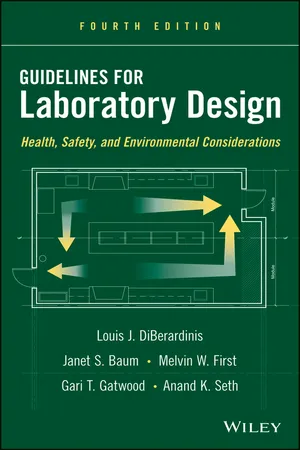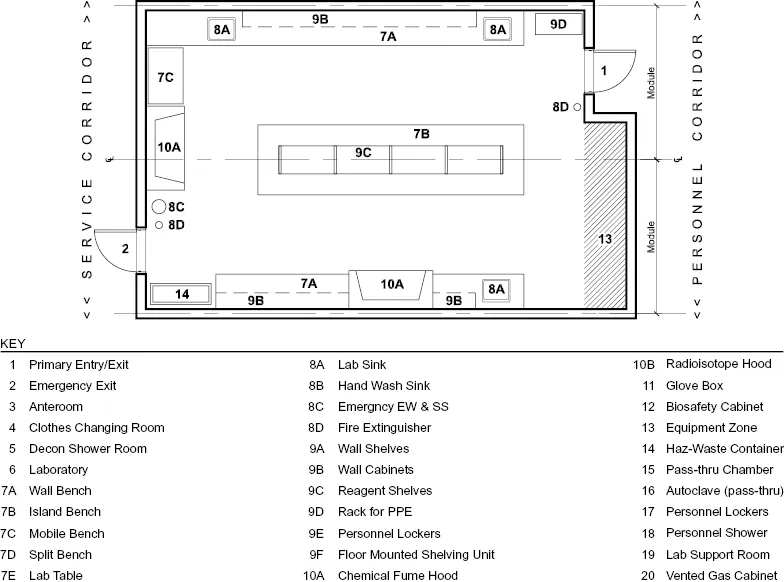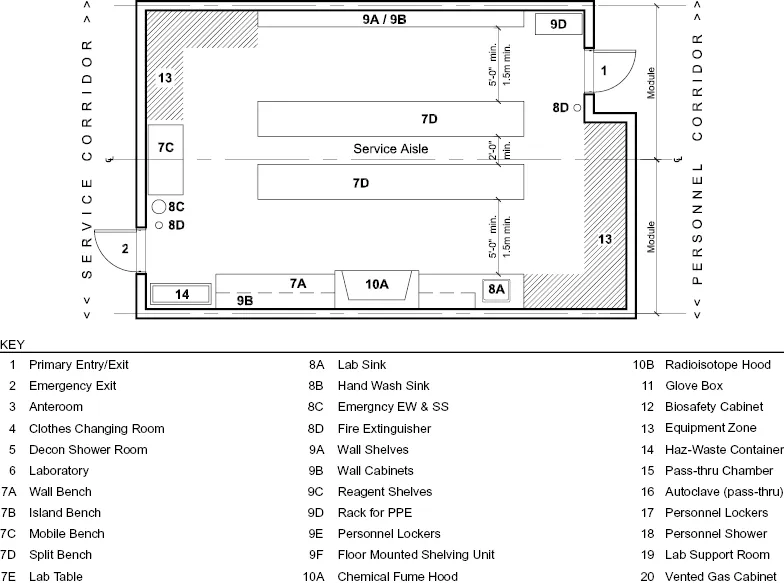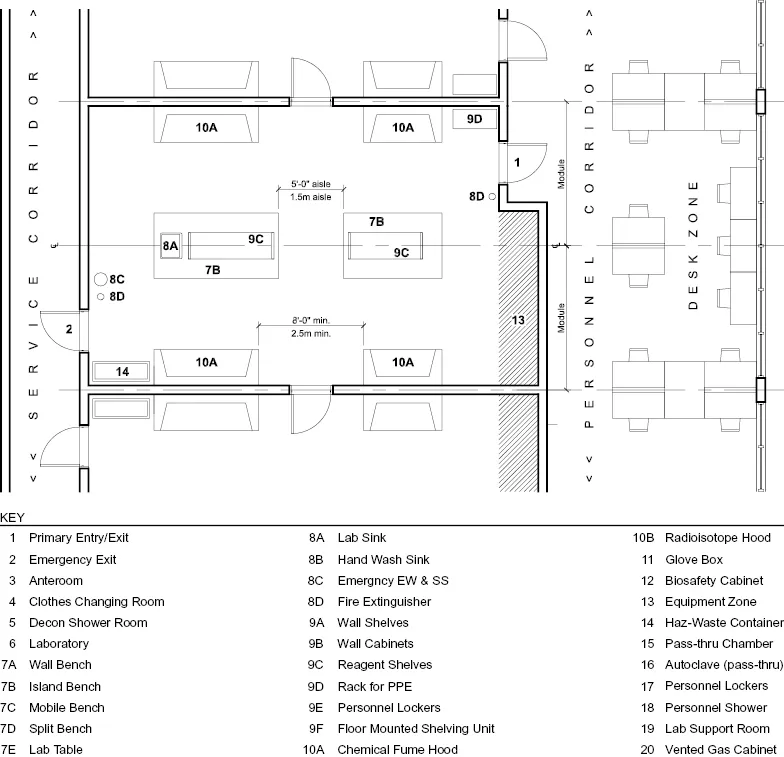The following chapters address environmental, safety, and health issues for a number of well-defined laboratory types. Laboratory type is determined largely by the hazardous properties and quantities of the materials and equipment normally used, the work activities performed, and any special requirements of the laboratory that may affect the environment or personnel’s safety and health adversely inside or outside the laboratory. It is of extreme importance that a specific laboratory type be selected in collaboration with laboratory users and safety and industrial hygiene advisors. After the laboratory type has been selected, all of the issues discussed in the chapter of this manual dealing with that specific laboratory type should be evaluated and implemented in the design stages. Therefore, the trend in research is to have more interdisciplinary collaboration. Quite frequently, the desired laboratory will be a combination of several types of laboratories and the applicable requirements of each should be adopted.
The items discussed under “Common Elements of Laboratory Design” (Part I, Section A) apply to all laboratories except when we exclude elements in specific laboratory chapters and provide alternatives. In each of the specific laboratory types, special requirements unique to that laboratory are addressed. They may supplement or supersede the requirements of the Common Elements section. Chapters 1 and 2 should be read before final discussions about the specific laboratory design. For renovation projects (Part I, Section B), it may not be possible to comply with all requirements because of constraints imposed by the existing facility. However, if any safety and health recommendations must be compromised, safety and industrial hygiene personnel or consultants should be approached for professional advice.
A matrix showing the major safety and health considerations that should be addressed for each laboratory type is provided in Appendix E. It is intended as a design refresher and as a quick overview of the detailed information given in the text.
5.1 Description
5.1.1 Introduction
General and analytical chemistry laboratories are designed, constructed, and operated to provide a safe and healthy work area for the analysis, experimentation, and quality control of a wide variety of chemicals ranging from nanograms to kilograms, although not in the same laboratory. Many analytical procedures call for handling moderate amounts of hazardous chemicals, including petroleum solvents, explosive gases, and toxic substances. Usually this type of laboratory will be located in a building containing other laboratory units; they should not be housed in office buildings.
5.1.2 Work Activities
General chemistry laboratory activities include mixing, heating, cooling, distilling, evaporating, diluting, and reacting chemicals for testing and experimentation. The activities performed in analytical chemistry laboratories are more specific, with the primary activity being sample analysis involving the mixing, blending, ashing, and digesting of various chemicals, or the preparation of materials for further manipulation. These functions require a number of analytical instruments, some of which contain, utilize, or produce hazardous radiation from lasers or microwaves. Most of this work is conducted on an open bench or in a laboratory chemical fume hood. Today’s instrumentation can measure at ppb levels; therefore, it may be very sensitive to ambient conditions. These conditions must be identified early in the design stage.
5.1.3 Equipment and Materials
Spectrophotometers, gas and liquid chromatographs, magnetic resonance spectroscopy and imaging instruments, scintillation counters, mass spectrometers, balances, microscopes, stills, extraction apparatus, ovens, and furnaces may be used in analytical chemistry laboratories. General chemistry laboratories may also have reactor vessels, evaporators, and crystallizers. Heavy use of some of this equipment will generate a significant heat load in the laboratory.
Hazardous materials used in analytical chemistry laboratories include small quantities of chemicals of high toxicity, volatile liquids, dusts, compressed gases, and flammables. Toxic materials may be reacted or decomposed into nontoxic compounds during the analytical procedures, but usually they remain in a toxic state during manipulation. Occasionally, nontoxic components may react to produce hazardous reaction products, but this is not usual.
If work with nanoparticles is to be conducted in this laboratory the additional requirements of Chapter 7 (Nanotechnology Laboratories) should be reviewed for applicability.
5.1.4 Exclusions
These chemistry laboratories are not designed (1) for handling extremely hazardous chemicals, (2) for using chemicals with unknown toxicity and/or hazardous properties, (3) or performing especially hazardous operations. Hazardous operations not recommended for general and analytical chemistry laboratories include, but are not limited to, the use of
- Carcinogenic, mutagenic, or teratogenic chemicals
- Highly explosive materials in greater than milligram quantities
- High-voltage and high-current electrical services
- Radiofrequency generators and all electrical operations with a high potential for fire, explosion, or electrocution
- Lasers of over 3-mw output power with unshielded beams
- Gas pressures exceeding 2,500 psig
- Liquid pressures exceeding 500 psig
- Radioactive materials in greater than 1-μci amounts
These operations are addressed in other laboratory types. General and analytic chemistry laboratories usually need no special access restrictions except when specialized or highly sensitive instruments are to be used, or when a normal building environment may contain contaminants in quantities that equal or exceed those measured in trace analysis laboratories. This type of laboratory is an exclusion laboratory.
5.2 Laboratory Layout
The layouts of an analytical chemistry laboratory and a general chemistry laboratory are similar (see Figures 5-1A and 1B). Each item addressed in Chapter 1, Section 1.2 and Chapter 2, Section 2.2 should be evaluated for its applicability to the specific needs of those who will use this facility, and items that are relevant should be implemented. The most important consideration in the layout is safely locating the number and sizes of chemical fume hoods required. In laboratories where multiple fume hoods are needed, a minimum of 4 ft (1.2 m) should be provided between fume hoods on the same wall. If only two fume hoods are needed, one hood on each side wall toward the rear of the laboratory is acceptable when the face-to-face distance is more than 10 ft (2.9 m).
Because it is likely that many pieces of analytical equipment of substantial size will be present in an analytical chemistry laboratory at all times, special care should be given to their location relative to egress routes, ventilation patterns, and the interactions of laboratory personnel with chemical handling operations. Access to the rear of bench-mounted analytical instruments is very important for gas, fluid, and vacuum lines, as well as for data transmission and power connections. Benches and countertops can be split and separated by a safe distance, minimum 2 ft (60 cm), to allow one person at a time access to the back of the instruments (Figure 5-2). Overhead service carriers for split lab benches can provide safety and flexibility because they bring cables and gas lines overhead instead of on the bench and floor. Additional bench space beside each instrument may be needed for sample preparation and loading to each piece of equipment. For bench top equipment, clearance for lifting covers or lids must be provided by carefully locating the equipment or removing shelving that may interfere with the ability to lift the covers. Services should be cleanable and easily wiped down. Alternatively, instrument racks (mobile or fixed) can be separated for access. When compressed gas cylinders are mounted in the service aisles, separation must increase between benches to allow safe access around cylinders.
Because most analytical instruments have interfaces with computers and printers, adequate areas should be provided for these devices. Fixed and mobile instrument racks can be designed for safe and efficient arrangement of peripheral devices as well as chemical supply and waste containers. Racks allow vertical storage of these components and afford greater floor area efficiency.
Floor-mounted instruments also need adequate clearances for connections to ancillary equipment and controls, and for servicing. Required clearances are shown in installation and service manuals that manufacturers provide with their instruments. Safety and industrial hygiene personnel should be consulted for assistance with special problems of hazardous chemical handling, magnetic fields, and laboratory ventilation. A suggested layout for a general or analytical chemistry laboratory is provided in Figures 5-1A and 1B. Figure 5-3 shows a chemistry facility where the desk stations for computer work are located outside the laboratories. Other layout options are shown in Figure 5-4. All items described in Sections 1.2 and 2.2 should be reviewed, and those that are relevant should be implemented.
Underfloor distribution of utilities by either a raised floor or utility trenches is not recommended because of the potential for spills of hazardous materials and the resultant collection of materials in these hard-to-access areas.
5.3 Heating, Ventilating, and Air-Conditioning
5.3.1 Introduction
All the items described in Chapter 1, Section 1.3 and Chapter 2, Section 2.3 should be reviewed, and those that are relevant should be implemented.
5.3.2 Additional HVAC Needs
Special consideration should be given to providing good coverage of the laboratory with local exhaust systems. The effluent gases from some analytical devices, such as gas chromatographs and atomic absorption spectrometers, often contain toxic chemicals that need to be controlled at the source of generation by being vented to the outdoors. In some cases, instrument manufacturers provide recommendations specific to their instruments. Otherwise, the Industrial Ventilation Manual (American Conference of Governmental Industrial Hygienists [ACGIH], 2010a) or a qualified industrial hygienist should be consulted for advice. Chapter 31, Air Cleaning, provides some examples of local exhaust ventilation that may be used for some equipment. If perchloric acid use is anticipated, the safety measures described in Chapter 2, Section 2.3.4.4.3 should be implemented.
Because of the density of heat-producing sources in analytical chemistry laboratories each of the analytical instruments and auxiliary equipment should be evaluated when estimating heating and air-conditioning requirements.





